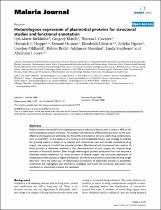 ResearchSpace
ResearchSpace
Heterologous expression of plasmodial proteins for structural studies and functional annotation
JavaScript is disabled for your browser. Some features of this site may not work without it.
- ResearchSpace
- →
- Research Publications/Outputs
- →
- Journal Articles
- →
- View Item
| dc.contributor.author |
Birkholtz, LM

|
|
| dc.contributor.author |
Blatch, G

|
|
| dc.contributor.author |
Coetzer, TL

|
|
| dc.contributor.author |
Hoppe, HC

|
|
| dc.contributor.author |
Human, E

|
|
| dc.contributor.author |
Morris, EJ

|
|
| dc.contributor.author |
Ngcete, Z

|
|
| dc.contributor.author |
Oldfield, LC

|
|
| dc.contributor.author |
Roth, Robyn L

|
|
| dc.contributor.author |
Shonhai, A

|
|
| dc.contributor.author |
Stephens, L

|
|
| dc.contributor.author |
Louw, AI

|
|
| dc.date.accessioned | 2009-02-18T08:19:46Z | |
| dc.date.available | 2009-02-18T08:19:46Z | |
| dc.date.issued | 2008 | |
| dc.identifier.citation | Birkholtz, L-M, Blatch, G, Coetzer, TL et al. 2008. Heterologous expression of plasmodial proteins for structural studies and functional annotation. Malaria Journal, Vol 7(197), pp 1-20 | en |
| dc.identifier.issn | 1475-2875 | |
| dc.identifier.uri | http://hdl.handle.net/10204/3015 | |
| dc.description | Copyright: 2008 BioMed Central Ltd | en |
| dc.description.abstract | Malaria remains the world's most devastating tropical infectious disease with as many as 40% of the world population living in risk areas. The widespread resistance of plasmodium parasites to the cost-effective chloroquine and antifolates has forced the introduction of more costly drug combinations, such as Coartem. In the absence of a vaccine in the foreseeable future, one strategy to address the growing malaria problem is to identify and characterize new and durable anti-malarial drug targets, the majority of which are parasite proteins. Biochemical and structure-activity analysis of these proteins is ultimately essential in the characterization of such targets but requires large amounts of functional protein. Even though heterologous protein production has now become a relatively routine endeavour for most proteins of diverse origins, the functional expression of soluble plasmodial proteins is highly problematic and slows the progress of anti-malarial drug target discovery. Here the status quo of heterologous production of plasmodial proteins is presented, constraints are highlighted and alternative strategies and hosts for functional expression and annotation of plasmodial proteins are reviewed | en |
| dc.language.iso | en | en |
| dc.publisher | BioMed Central | en |
| dc.subject | Antimalarial drugs | en |
| dc.subject | Parasite proteins | en |
| dc.subject | Plasmodial proteins | en |
| dc.title | Heterologous expression of plasmodial proteins for structural studies and functional annotation | en |
| dc.type | Article | en |
| dc.identifier.apacitation | Birkholtz, L., Blatch, G., Coetzer, T., Hoppe, H., Human, E., Morris, E., ... Louw, A. (2008). Heterologous expression of plasmodial proteins for structural studies and functional annotation. http://hdl.handle.net/10204/3015 | en_ZA |
| dc.identifier.chicagocitation | Birkholtz, LM, G Blatch, TL Coetzer, HC Hoppe, E Human, EJ Morris, Z Ngcete, et al "Heterologous expression of plasmodial proteins for structural studies and functional annotation." (2008) http://hdl.handle.net/10204/3015 | en_ZA |
| dc.identifier.vancouvercitation | Birkholtz L, Blatch G, Coetzer T, Hoppe H, Human E, Morris E, et al. Heterologous expression of plasmodial proteins for structural studies and functional annotation. 2008; http://hdl.handle.net/10204/3015. | en_ZA |
| dc.identifier.ris | TY - Article AU - Birkholtz, LM AU - Blatch, G AU - Coetzer, TL AU - Hoppe, HC AU - Human, E AU - Morris, EJ AU - Ngcete, Z AU - Oldfield, LC AU - Roth, Robyn L AU - Shonhai, A AU - Stephens, L AU - Louw, AI AB - Malaria remains the world's most devastating tropical infectious disease with as many as 40% of the world population living in risk areas. The widespread resistance of plasmodium parasites to the cost-effective chloroquine and antifolates has forced the introduction of more costly drug combinations, such as Coartem. In the absence of a vaccine in the foreseeable future, one strategy to address the growing malaria problem is to identify and characterize new and durable anti-malarial drug targets, the majority of which are parasite proteins. Biochemical and structure-activity analysis of these proteins is ultimately essential in the characterization of such targets but requires large amounts of functional protein. Even though heterologous protein production has now become a relatively routine endeavour for most proteins of diverse origins, the functional expression of soluble plasmodial proteins is highly problematic and slows the progress of anti-malarial drug target discovery. Here the status quo of heterologous production of plasmodial proteins is presented, constraints are highlighted and alternative strategies and hosts for functional expression and annotation of plasmodial proteins are reviewed DA - 2008 DB - ResearchSpace DP - CSIR KW - Antimalarial drugs KW - Parasite proteins KW - Plasmodial proteins LK - https://researchspace.csir.co.za PY - 2008 SM - 1475-2875 T1 - Heterologous expression of plasmodial proteins for structural studies and functional annotation TI - Heterologous expression of plasmodial proteins for structural studies and functional annotation UR - http://hdl.handle.net/10204/3015 ER - | en_ZA |





